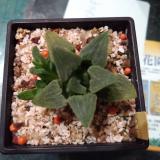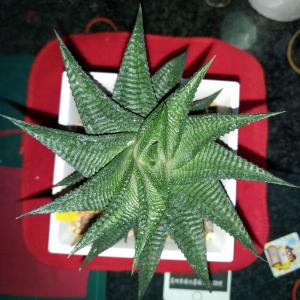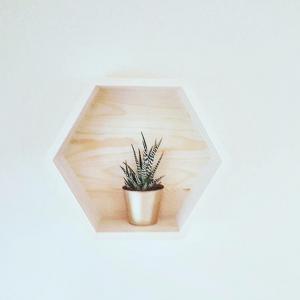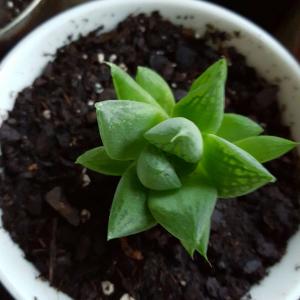成长记
Kiersten_27
2017年10月20日

I now added "Haworthia coarctata ver greenii" in my "garden"
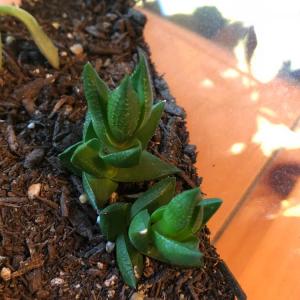

2
0
brielle:So cute!
成长记
Ueca
2017年10月20日

Added a H. cuspidata. You can recognize it from its colour, which is lighter than the colour of most other Haworthia.
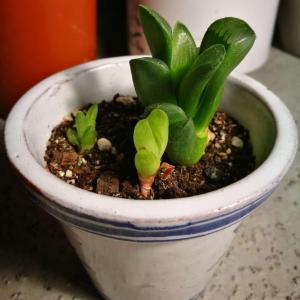

3
0
成长记
Kiersten_27
2017年10月18日

I now added "Haworthia cooperi" in my "garden"


2
0
Kiersten_27:@Ueca That’s how it was when I got it, but it’s staying healthy.
Ueca:This plant's leaves look like flat tires. 🕳💨
成长记
Kiersten_27
2017年10月17日

I now added "Zebra haworthia" in my "garden"


5
0
萌萌的南瓜:It looks so cute ✨🌸
成长记
meriunkat
2017年10月16日

I now added "Haworthia Fasciata" in my "garden"


2
0
meriunkat:@Ueca I asked myself the same question 😅 a friend gave it to me because it was dying on her
Ueca:Why has it got those wild tentacles?
成长记
Vickyvictoria Li
2017年10月07日

I new added a "Haworthia Cymbiformis Triebnet" in my "garden"


0
1
Vickyvictoria Li:@Ueca Thanks for help me find out the ID 😍
Ueca:The cultivar is prolifera. Haworthia cymbiformis var. prolifera.
文章
Dummer. ゛☀
2017年10月02日

Scientific Name
Haworthia attenuata (Haw.) Haw.

Common Names
Zebra Plant, Zebra Haworthia
Synonyms
Haworthia attenuata var. attenuata, Apicra attenuata, Aloe clariperla
Scientific Classification
Family: Xanthorrhoeaceae
Subfamily: Asphodeloideae
Genus: Haworthia

Flower
Color: White and green
Bloom Time: Can be ever blooming if you snip off each bloom when it dies.
Description
Haworthia attenuata is a stemless clustering perennial succulent, up to 6 inches (15 cm) tall. The rosettes are 3 – 6 inches (7 – 15 cm) in diameter, with 30 – 40 dark green leaves, 3 inches (8 cm) long with white tubercles. The Inflorescence is 16 inches (40 cm) tall, white flower with green veins.
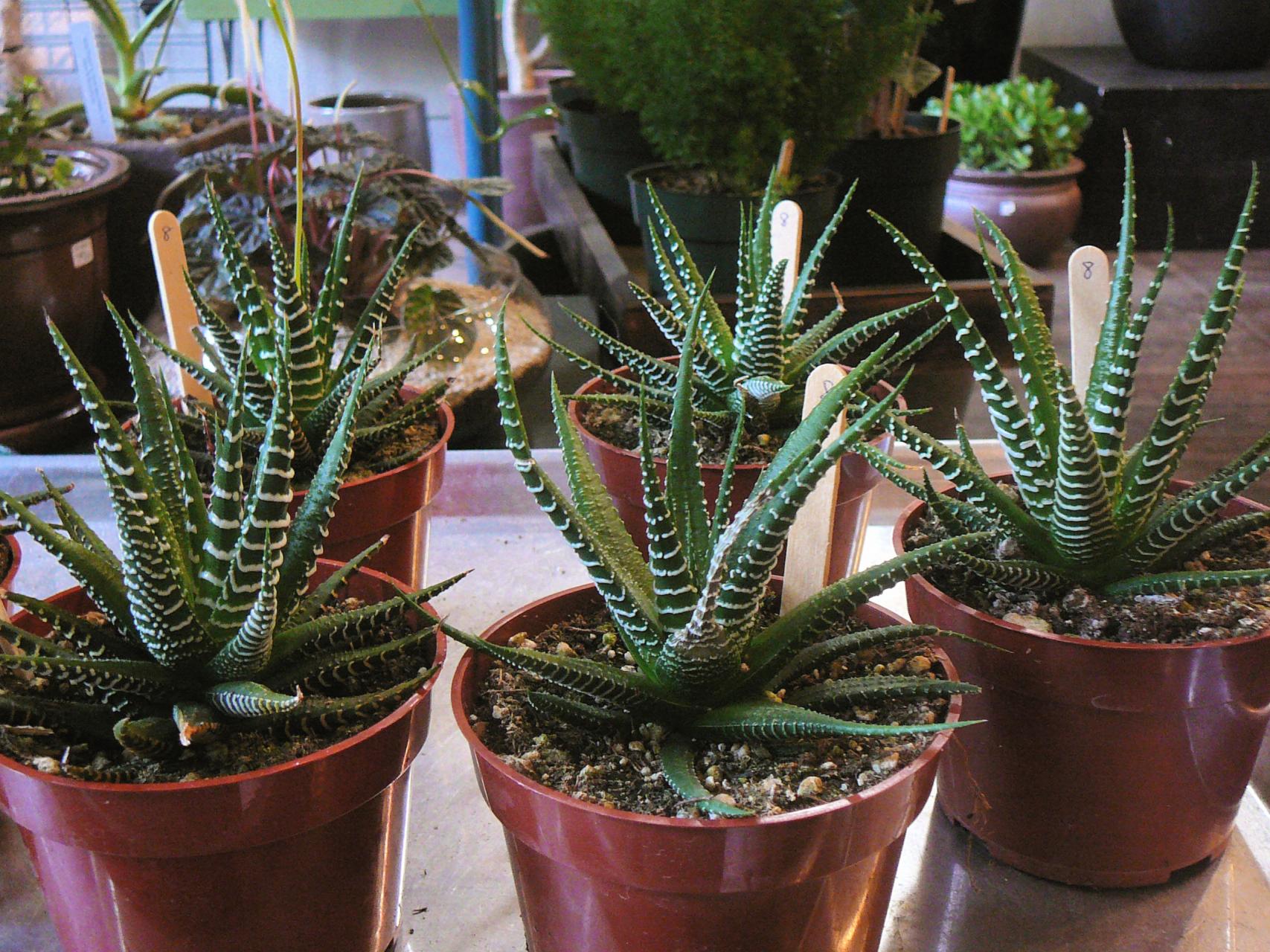
How to Grow and Care
Display Zebra Plant anywhere it can receive plenty of sun or bright light. South facing windows will provide the most sun, however, east or west provide direct sun part of the day that I find more suitable.
During the growing season from April to September water the Zebra Plant thoroughly and then water when the soil becomes dry to the touch (not bone dry though). Winter is a tricky time for these plants although they are a tough species. Many growers will overwater then alongside cold temperatures or drafts the plant can become very sick, or even die. The leaves are storage organs so during the winter water much less and allow the top soil to dry out.
Use a cactus potting mix that drains wells and provides plenty of air to the small roots. If making you own mix or buying another type, use part potting soil, part perlite and part sand.
Origin
Native to South Africa (Eastern Cape).
Haworthia attenuata (Haw.) Haw.

Common Names
Zebra Plant, Zebra Haworthia
Synonyms
Haworthia attenuata var. attenuata, Apicra attenuata, Aloe clariperla
Scientific Classification
Family: Xanthorrhoeaceae
Subfamily: Asphodeloideae
Genus: Haworthia

Flower
Color: White and green
Bloom Time: Can be ever blooming if you snip off each bloom when it dies.
Description
Haworthia attenuata is a stemless clustering perennial succulent, up to 6 inches (15 cm) tall. The rosettes are 3 – 6 inches (7 – 15 cm) in diameter, with 30 – 40 dark green leaves, 3 inches (8 cm) long with white tubercles. The Inflorescence is 16 inches (40 cm) tall, white flower with green veins.

How to Grow and Care
Display Zebra Plant anywhere it can receive plenty of sun or bright light. South facing windows will provide the most sun, however, east or west provide direct sun part of the day that I find more suitable.
During the growing season from April to September water the Zebra Plant thoroughly and then water when the soil becomes dry to the touch (not bone dry though). Winter is a tricky time for these plants although they are a tough species. Many growers will overwater then alongside cold temperatures or drafts the plant can become very sick, or even die. The leaves are storage organs so during the winter water much less and allow the top soil to dry out.
Use a cactus potting mix that drains wells and provides plenty of air to the small roots. If making you own mix or buying another type, use part potting soil, part perlite and part sand.
Origin
Native to South Africa (Eastern Cape).
6
6
文章
Dummer. ゛☀
2017年10月02日

Scientific Name
Haworthia nigra (Haw.) Baker
Common Names
Black Haworthia
Synonyms
Haworthia nigra var. nigra, Aloe nigra, Apicra nigra, Catevala nigra, Haworthia venosa subsp. nigra, Haworthia ryneveldii, Haworthia schmidtiana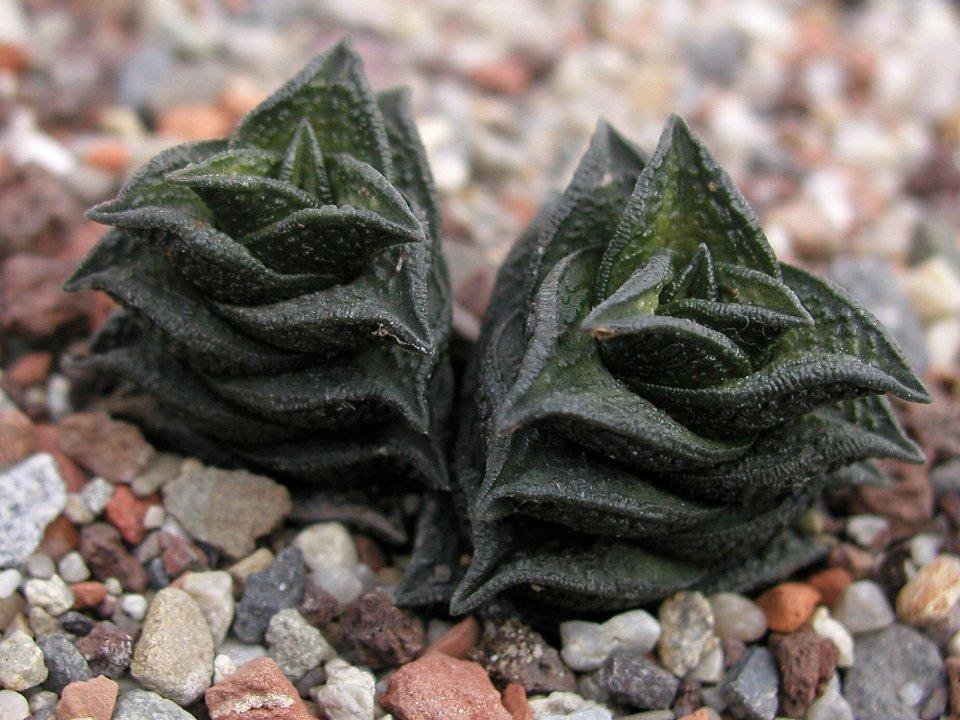
Scientific Classification
Family: Xanthorrhoeaceae
Subfamily: Asphodeloideae
Genus: Haworthia
Description
Haworthia nigra is a slow-growing, erect succulent with deep greenish-black leaves, up to 4 inches (10 cm) tall. The pointy, partially folded, stiff leaves emerge from the center of the rosette. Outer and inner leaf sides have ridged, gray bumps called tubercles. Each new leathery leaf emerges from the center atop the one below it, which lends plants a stacked or tiered look. In winter’s chill or under excessive drought stress plants blush red. Overall, the foliage remains dark green with varying grades of gray to black. In late spring or summer, mature rosettes produce single, upright, wiry flower stems topped with tiny white flowers.
How to Grow and Care
Haworthia are not considered difficult houseplants to grow—if you can keep a pot of aloe alive on a windowsill, chances are you can do the same with a dish of Haworthia. As with all succulents, the most dangerous situation is too much water—they should never be allowed to sit in water under any circumstances. At the same time, these decorative little plants can be grown in interesting containers such as tea cups and even miniature baby shoes. If you’re given a Haworthia in such a container, make sure the container had adequate drainage. If it doesn’t, it might be a good idea to pop the plant out of its container and add a layer of gravel to the bottom to reduce the wicking action of the soil above. Finally, look out for sunburned spots on your plants.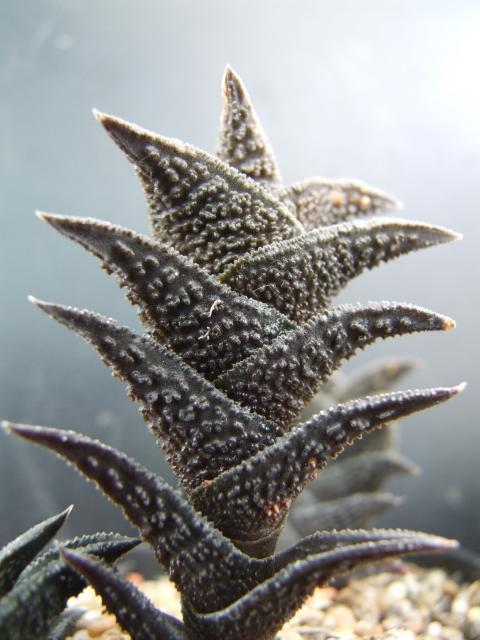
Haworthia are small (usually remaining between 3 inches (7.5 cm) and 5 (12.5 cm) inches in height) and relatively slow-growing. They are often grown in small clusters in wide, shallow dishes. Over time, clusters will naturally enlarge as the mother plant sends off small plantlets.
Haworthia nigra (Haw.) Baker
Common Names
Black Haworthia
Synonyms
Haworthia nigra var. nigra, Aloe nigra, Apicra nigra, Catevala nigra, Haworthia venosa subsp. nigra, Haworthia ryneveldii, Haworthia schmidtiana

Scientific Classification
Family: Xanthorrhoeaceae
Subfamily: Asphodeloideae
Genus: Haworthia

Description
Haworthia nigra is a slow-growing, erect succulent with deep greenish-black leaves, up to 4 inches (10 cm) tall. The pointy, partially folded, stiff leaves emerge from the center of the rosette. Outer and inner leaf sides have ridged, gray bumps called tubercles. Each new leathery leaf emerges from the center atop the one below it, which lends plants a stacked or tiered look. In winter’s chill or under excessive drought stress plants blush red. Overall, the foliage remains dark green with varying grades of gray to black. In late spring or summer, mature rosettes produce single, upright, wiry flower stems topped with tiny white flowers.

How to Grow and Care
Haworthia are not considered difficult houseplants to grow—if you can keep a pot of aloe alive on a windowsill, chances are you can do the same with a dish of Haworthia. As with all succulents, the most dangerous situation is too much water—they should never be allowed to sit in water under any circumstances. At the same time, these decorative little plants can be grown in interesting containers such as tea cups and even miniature baby shoes. If you’re given a Haworthia in such a container, make sure the container had adequate drainage. If it doesn’t, it might be a good idea to pop the plant out of its container and add a layer of gravel to the bottom to reduce the wicking action of the soil above. Finally, look out for sunburned spots on your plants.

Haworthia are small (usually remaining between 3 inches (7.5 cm) and 5 (12.5 cm) inches in height) and relatively slow-growing. They are often grown in small clusters in wide, shallow dishes. Over time, clusters will naturally enlarge as the mother plant sends off small plantlets.
0
1


